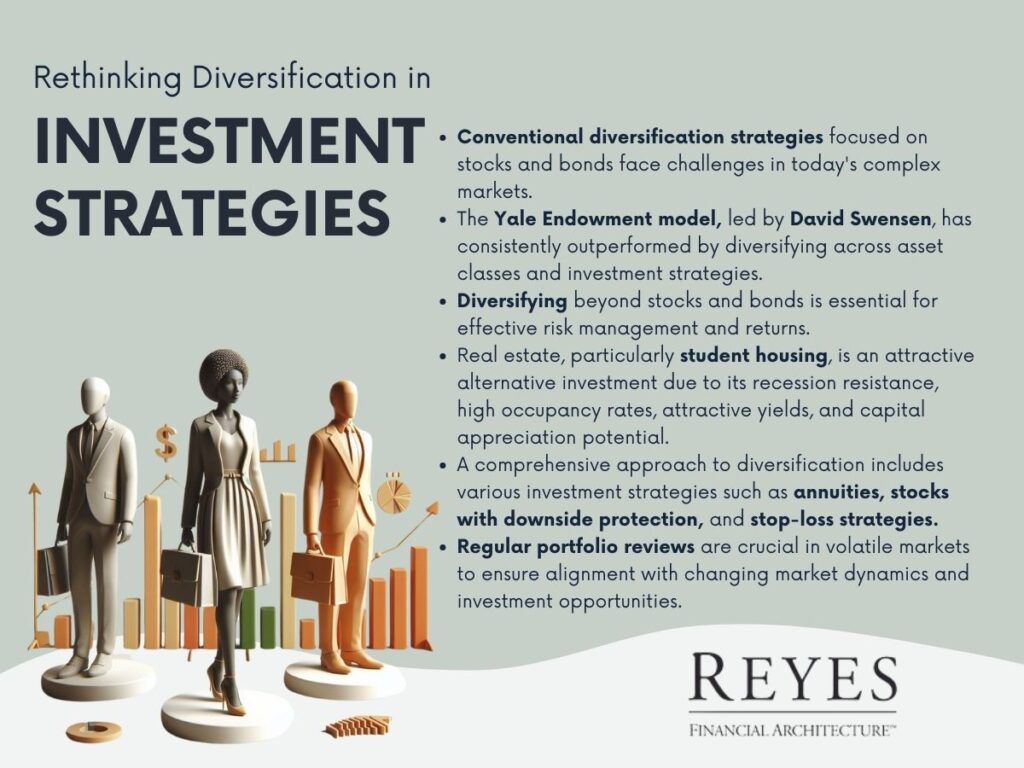This week's LIVE! in studio recording gives strategic advice and insight on how to Have a Truly Diversified Portfolio. Watch the video or catch the replay at www.reyesplan.com/radio
Conventional diversification in investment and retirement planning, centered on stocks and bonds, faces challenges in today's intricate markets. The Yale Endowment model, led by David Swensen, has consistently outperformed by diversifying across asset classes and investment strategies.
In this article, we explore the necessity of diversifying beyond stocks and bonds, examining alternatives like student housing. We stress the importance of comprehensive portfolio management in volatile markets and encourage investors to seek professional guidance for optimal diversification and returns.

The commonly held belief about diversification in retirement and investment planning is often rooted in a simplistic approach, mainly focusing on stocks and bonds. However, this conventional wisdom is increasingly challenged by evolving market dynamics. For example, during the financial turmoil of 2000 and 2008, both stocks and bonds fell simultaneously, undermining the effectiveness of traditional diversification strategies.
A significant example that challenges the traditional approach is the Yale Endowment model, managed by David Swensen. Since 1985, Swensen's management has consistently outperformed the market, despite holding only about 30% in stocks. The Yale model's success is attributed to its diversification strategy, not just across asset classes but also in terms of investment strategy.
The Yale model and other successful endowment funds employ a broader spectrum of investments, including real estate and other alternative assets. This approach contrasts starkly with the typical offerings of major investment firms, which usually limit their portfolios to stocks and bonds in various combinations.
Real estate, particularly student housing, emerges as a compelling investment option within this diversified strategy framework. Investing in student housing near prominent universities, such as USC, Notre Dame, and others, provides a stable and recession-resistant asset class. These properties often have high occupancy rates and are less affected by economic downturns since education demand remains relatively constant regardless of the market cycle.
A truly diversified portfolio extends beyond just mixing asset classes; it involves incorporating various investment strategies. This might include using annuities, real estate, stocks with downside protection, and employing stop-loss strategies to mitigate risk. For instance, a stop-loss strategy involves moving to bonds if the overall portfolio drops by a set percentage, thus limiting losses.
Given the market's volatility, not witnessed since 2008, investors are advised to seek a comprehensive review of their portfolios. This could involve consulting multiple advisors to gain different perspectives. A thorough review can reveal whether an investor's current strategy aligns with the evolving nature of markets and the broader spectrum of available investment opportunities.
The traditional approach to diversification, primarily centered around stocks and bonds, is increasingly inadequate in the face of modern market complexities. Embracing a more holistic view, as exemplified by the Yale Endowment model, involves diversifying across different asset classes and investment strategies.
This approach not only reduces risk but also opens up opportunities for higher returns. Investors are encouraged to review their portfolios with these considerations in mind, seeking professional advice to navigate the complexities of today's investment landscape.